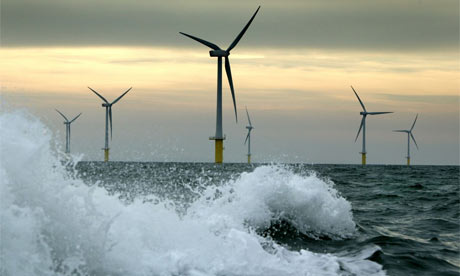 A recent NZ Wind Energy Association newsletter carries some cheering news — enough, I thought, to deserve a Hot Topicupdate on wind energy. 2009 saw a record 50% capacity growth in wind power in New Zealand. A further 25% capacity growth is expected over the next twelve months. At the beginning of 2009 wind farms were supplying about 2.5% of our elecricity. Currently wind generation supplies about 4%, and in the last quarter of 2009 wind generation peaked at close to 5% of total generation.
A recent NZ Wind Energy Association newsletter carries some cheering news — enough, I thought, to deserve a Hot Topicupdate on wind energy. 2009 saw a record 50% capacity growth in wind power in New Zealand. A further 25% capacity growth is expected over the next twelve months. At the beginning of 2009 wind farms were supplying about 2.5% of our elecricity. Currently wind generation supplies about 4%, and in the last quarter of 2009 wind generation peaked at close to 5% of total generation.
In 2009, increasing wind generation, combined with full hydro lakes, resulted in renewable generation in New Zealand providing 73 per cent of total generation – the highest level of renewable generation since 2004. Consequently emissions from electricity generation during 2009 were down to their lowest level since 2002.
The newsletter comments on the role high levels of emissions-free renewable generation will play in reducing the impact of carbon pricing on electricity prices, as the electricity sector is set to enter the Emissions Trading Scheme later this year.
The Mahinerangi wind farm 70 kilometres west of Dunedin is set to start construction in September of this year, with stage one completed by May 2011. There’s a significant local synergy with the Waipori hydro scheme which TrustPower says will allow better efficiency from Waipori. The wind farm will also improve security of supply for Dunedin and free up for use elsewhere electricity currently being imported into Dunedin from Roxburgh and the Waitaki system.
The newsletter points to the synergy between these two generating schemes as illustrating at regional level what will be achieved on a national scale as wind energy is developed and operated in combination with existing hydro generation. Essentially, the use of wind enables water to be saved in storage lakes, until the water is needed for meeting peaks in demand.
Wind farms benefit regional economies. TrustPower expects the development of Mahinerangi to result in $12 million flowing directly into the local economy. A case study of the Manawatu wind farm Tararua Stage 3 showed significant amounts spent locally during construction and ongoing annual local expenditure by the operating company.
Wind power is on the move globally. The world’s wind power capacity grew by 31% in 2009, adding 37.5 gigawatts (GW) to bring total installations up to 157.9 GW. A third of these additions were made in China. In Europe just over 10GW of wind was installed, making it the leading source of new electricity-generating technology in the region, ahead of natural gas. The prediction is that in 2014, five years from now, global wind capacity will stand at 409 GW. (New Zealand’s total electricity capacity, from all sources, is around 9 GW.)
There’s some interesting material on prices. Because wind energy is a price taker in the electricity market it displaces more expensive generation, which is typically thermal generation. Uncertainty and risk attend the availability and cost of fuel for thermal generation. The newsletter contrasts this with the confidence about the cost of electricity over the lifespan of wind farms because they have no fuel costs, and low and well-understood operating and maintenance costs. A report prepared by an independent consultancy for the European Wind Energy Association found that wind power reduces electricity prices. The report reviewed the findings of case studies in Germany, Denmark and Belgium, which show electricity prices were reduced by between 3 and 23 Euros per MWh depending on the amount of wind power on the system. A similar trend is seen in New Zealand in the Manawatu, where wind reduces spot prices by an average of 10 per cent.
The progress of the New Zealand turbine manufacturer Windflow Technology towards achieving international certification for its 500 kW turbine is noted in the newsletter. It needs only approval of the tower design to complete Class 1A certification, meaning it would be suitable for use at the windiest and most turbulent sites and be capable of surviving gusts of over 250 km/h. The company sees a place for its smaller turbines on exposed ridge top sites.

 Ben McNeil’s scenario, in
Ben McNeil’s scenario, in